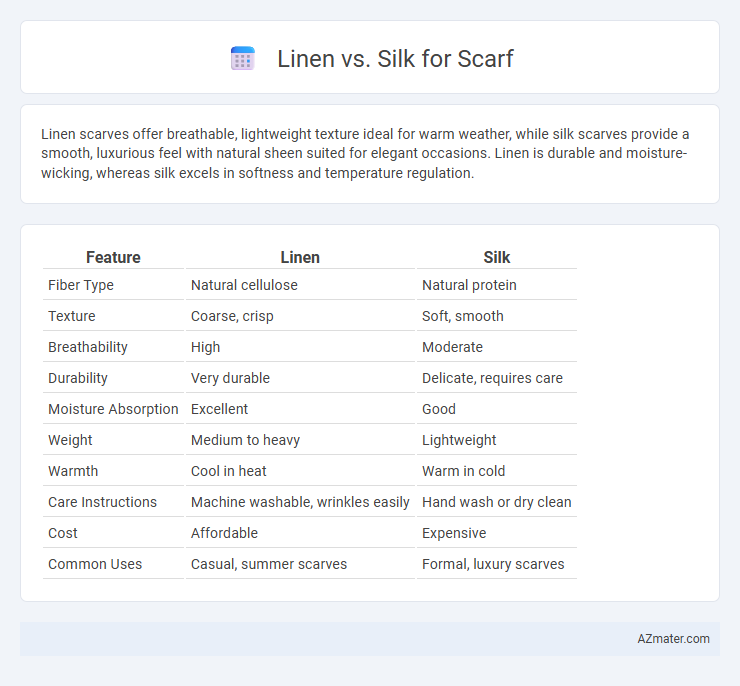Linen scarves offer breathable, lightweight texture ideal for warm weather, while silk scarves provide a smooth, luxurious feel with natural sheen suited for elegant occasions. Linen is durable and moisture-wicking, whereas silk excels in softness and temperature regulation.
Table of Comparison
| Feature | Linen | Silk |
|---|---|---|
| Fiber Type | Natural cellulose | Natural protein |
| Texture | Coarse, crisp | Soft, smooth |
| Breathability | High | Moderate |
| Durability | Very durable | Delicate, requires care |
| Moisture Absorption | Excellent | Good |
| Weight | Medium to heavy | Lightweight |
| Warmth | Cool in heat | Warm in cold |
| Care Instructions | Machine washable, wrinkles easily | Hand wash or dry clean |
| Cost | Affordable | Expensive |
| Common Uses | Casual, summer scarves | Formal, luxury scarves |
Introduction: Linen vs Silk Scarves
Linen scarves offer exceptional breathability and durability, making them ideal for warm weather and everyday use. Silk scarves provide a luxurious sheen and smooth texture, often chosen for their elegance and softness. Both materials have distinct qualities that influence comfort, appearance, and care requirements in scarf selection.
Fabric Origins and History
Linen, derived from the flax plant, boasts a history dating back over 8,000 years and was highly valued in ancient Egypt for its durability and breathability. Silk originates from the mulberry silkworm in China, with a legacy spanning more than 5,000 years, prized for its luxurious texture and sheen. Both fabrics have unique cultural significance, influencing textile production and fashion across different civilizations.
Texture and Feel Comparison
Linen scarves offer a slightly coarse texture with a natural, breathable feel that softens over time, making them ideal for warm weather and casual wear. Silk scarves present a smooth, luxurious texture with a cool, lightweight touch that drapes elegantly and feels gentle against the skin. The choice between linen and silk scarves depends on desired tactile comfort and the season, with linen providing a crisp, airy sensation and silk delivering a sleek, polished finish.
Breathability and Comfort
Linen scarves excel in breathability due to their natural fiber structure, allowing air to flow freely and keeping the skin cool and dry. Silk scarves offer a smooth, soft texture that feels luxurious against the skin but provides less ventilation, making them warmer to wear. Choosing linen for hot climates enhances comfort through moisture-wicking properties, while silk is ideal for cooler environments where a gentle warmth is preferred.
Durability and Longevity
Linen scarves are known for their exceptional durability due to the strong flax fibers, making them resistant to wear and tear over time. Silk scarves, while luxurious and smooth, are more delicate and prone to damage from abrasion and exposure to sunlight, reducing their longevity. Choosing linen ensures a scarf that maintains its integrity and appearance through frequent use and washing.
Style and Elegance
Linen scarves offer a casual, natural texture that complements bohemian and rustic fashion styles, making them ideal for relaxed elegance. Silk scarves exude a smooth, glossy finish with rich colors and intricate patterns, enhancing formal and sophisticated looks. Choosing silk elevates an outfit with timeless luxury, while linen appeals through understated, breathable charm.
Care and Maintenance
Linen scarves require gentle hand washing or dry cleaning to maintain their texture and prevent shrinkage, as hot water and harsh detergents can damage fibers. Silk scarves demand even more delicate care, preferring cold water, mild detergent, and avoidance of direct sunlight to preserve their natural sheen and prevent color fading. Both materials benefit from air drying flat to retain shape and avoid distortion, with silk needing extra caution to prevent water spots and fabric weakening.
Seasonal Suitability
Linen scarves excel in hot, humid climates due to their breathable fibers and moisture-wicking properties, making them ideal for summer wear. Silk scarves offer lightweight warmth and a smooth texture suitable for transitional seasons like spring and fall, providing moderate insulation without overheating. Both materials balance comfort and style, but linen outperforms silk in high temperatures while silk adds elegance and warmth for cooler conditions.
Pricing and Value
Linen scarves generally offer a more affordable price point due to the lower cost of raw materials and simpler production processes, making them a budget-friendly option without sacrificing durability. Silk scarves, often priced higher, provide luxurious softness and natural sheen, reflecting the premium quality and craftsmanship involved. The value of silk lies in its elegance and smooth texture, whereas linen scarves deliver practicality and breathability, catering to different consumer preferences.
Choosing the Best Scarf for You
Linen scarves offer breathable, lightweight comfort ideal for warm weather, while silk scarves provide a smooth, luxurious feel perfect for elegant, formal occasions. Consider factors like climate, skin sensitivity, and desired texture when choosing between linen's natural matte finish and silk's glossy sheen. Selecting the best scarf depends on balancing durability, maintenance, and personal style preferences for optimal wearability.

Infographic: Linen vs Silk for Scarf
 azmater.com
azmater.com